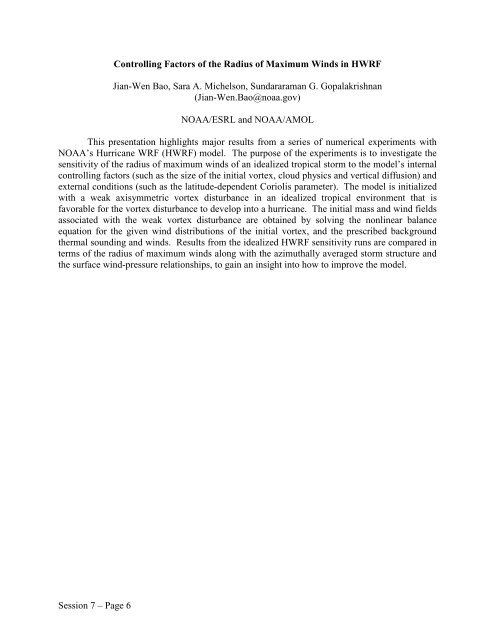65th IHC Booklet/Program (pdf - 4.9MB) - Office of the Federal ...
65th IHC Booklet/Program (pdf - 4.9MB) - Office of the Federal ...
65th IHC Booklet/Program (pdf - 4.9MB) - Office of the Federal ...
You also want an ePaper? Increase the reach of your titles
YUMPU automatically turns print PDFs into web optimized ePapers that Google loves.
Controlling Factors <strong>of</strong> <strong>the</strong> Radius <strong>of</strong> Maximum Winds in HWRF<br />
Jian-Wen Bao, Sara A. Michelson, Sundararaman G. Gopalakrishnan<br />
(Jian-Wen.Bao@noaa.gov)<br />
NOAA/ESRL and NOAA/AMOL<br />
This presentation highlights major results from a series <strong>of</strong> numerical experiments with<br />
NOAA’s Hurricane WRF (HWRF) model. The purpose <strong>of</strong> <strong>the</strong> experiments is to investigate <strong>the</strong><br />
sensitivity <strong>of</strong> <strong>the</strong> radius <strong>of</strong> maximum winds <strong>of</strong> an idealized tropical storm to <strong>the</strong> model’s internal<br />
controlling factors (such as <strong>the</strong> size <strong>of</strong> <strong>the</strong> initial vortex, cloud physics and vertical diffusion) and<br />
external conditions (such as <strong>the</strong> latitude-dependent Coriolis parameter). The model is initialized<br />
with a weak axisymmetric vortex disturbance in an idealized tropical environment that is<br />
favorable for <strong>the</strong> vortex disturbance to develop into a hurricane. The initial mass and wind fields<br />
associated with <strong>the</strong> weak vortex disturbance are obtained by solving <strong>the</strong> nonlinear balance<br />
equation for <strong>the</strong> given wind distributions <strong>of</strong> <strong>the</strong> initial vortex, and <strong>the</strong> prescribed background<br />
<strong>the</strong>rmal sounding and winds. Results from <strong>the</strong> idealized HWRF sensitivity runs are compared in<br />
terms <strong>of</strong> <strong>the</strong> radius <strong>of</strong> maximum winds along with <strong>the</strong> azimuthally averaged storm structure and<br />
<strong>the</strong> surface wind-pressure relationships, to gain an insight into how to improve <strong>the</strong> model.<br />
Session 7 – Page 6
















